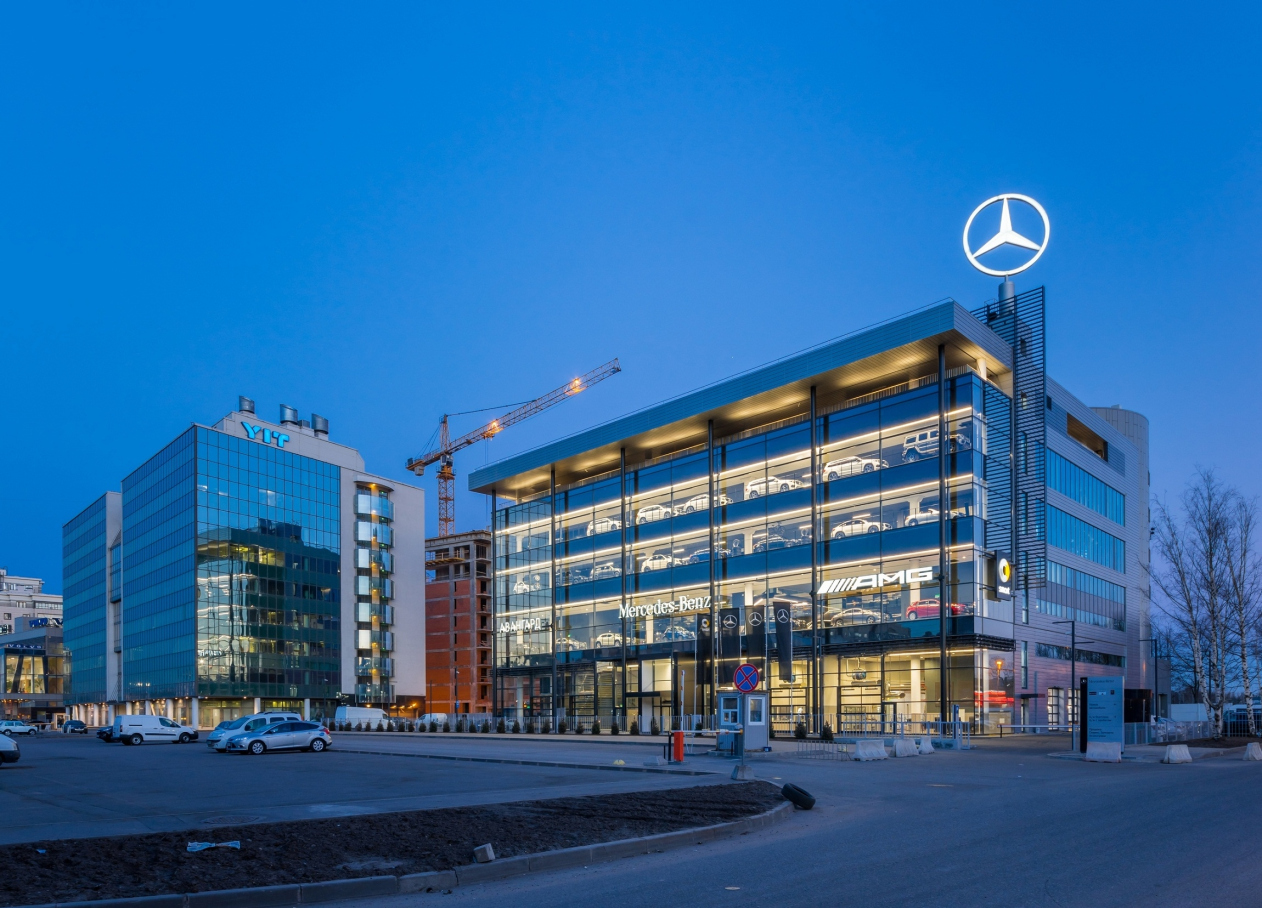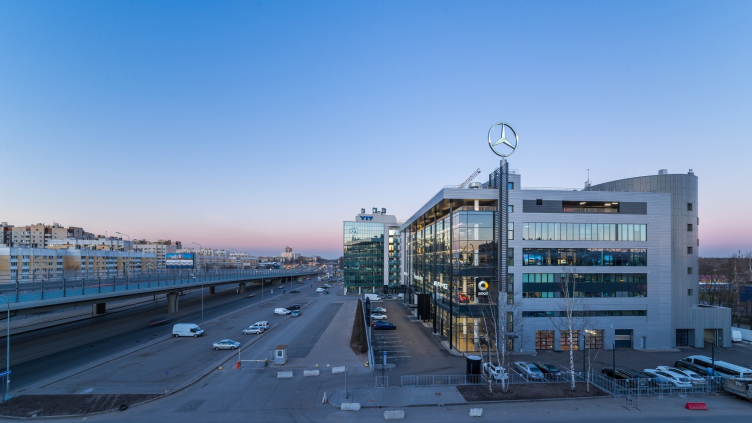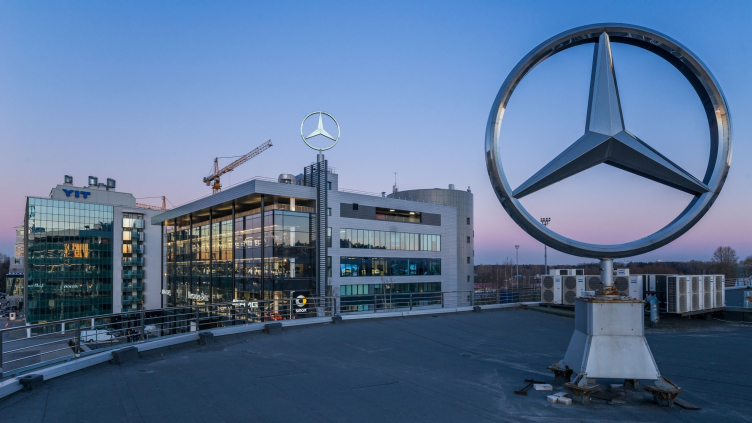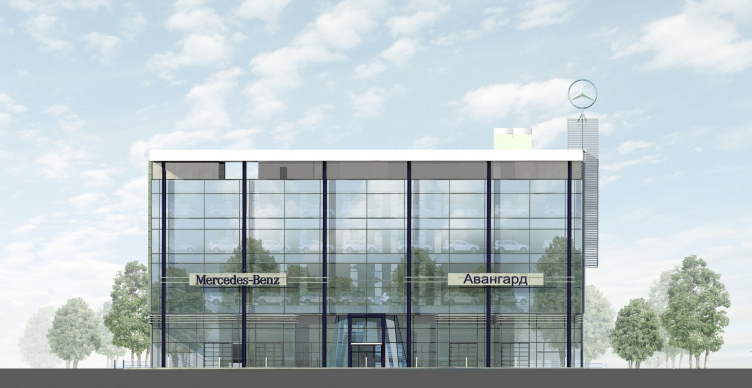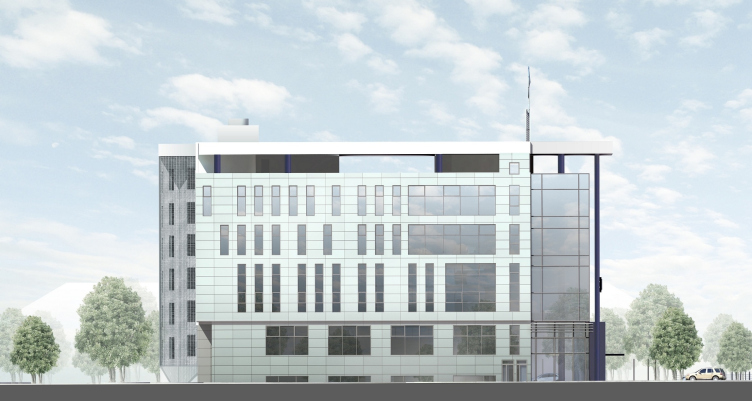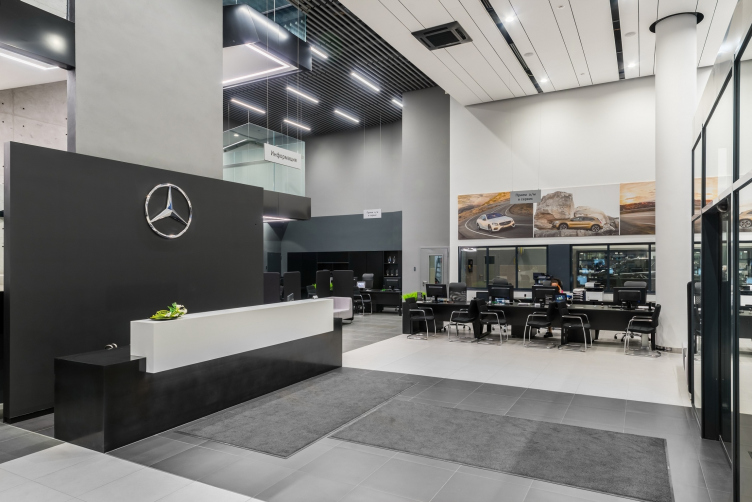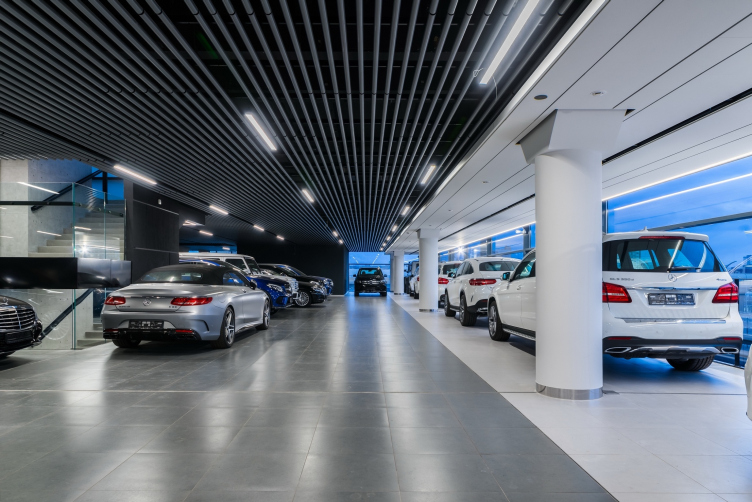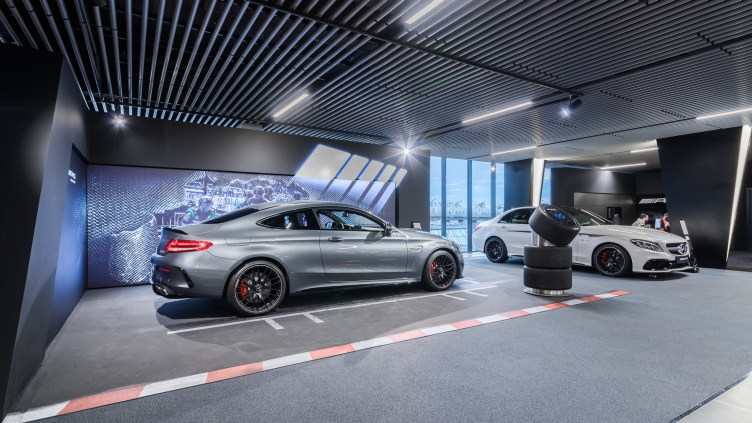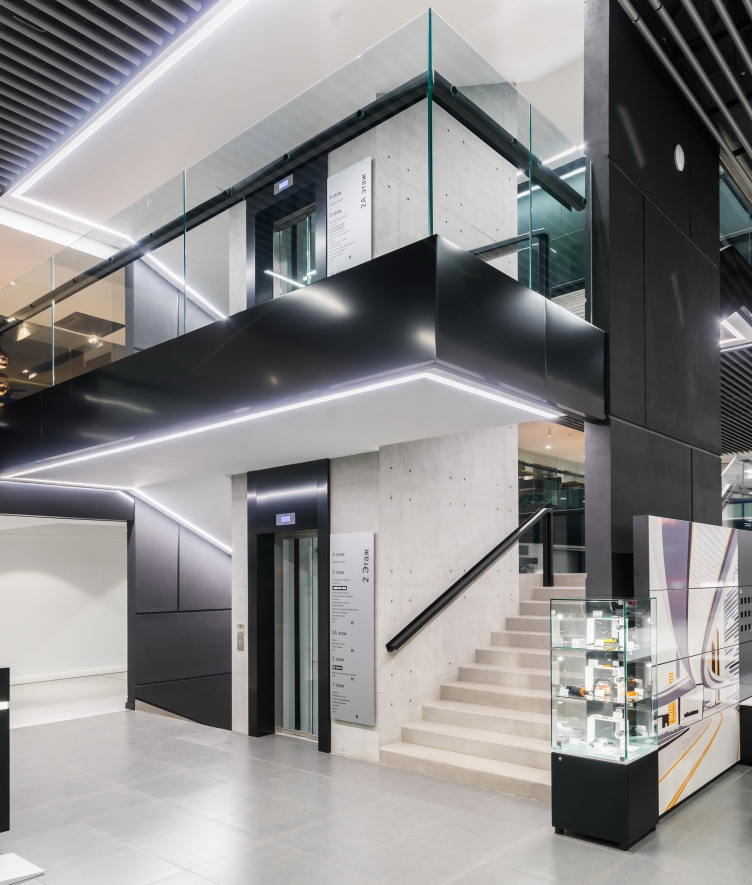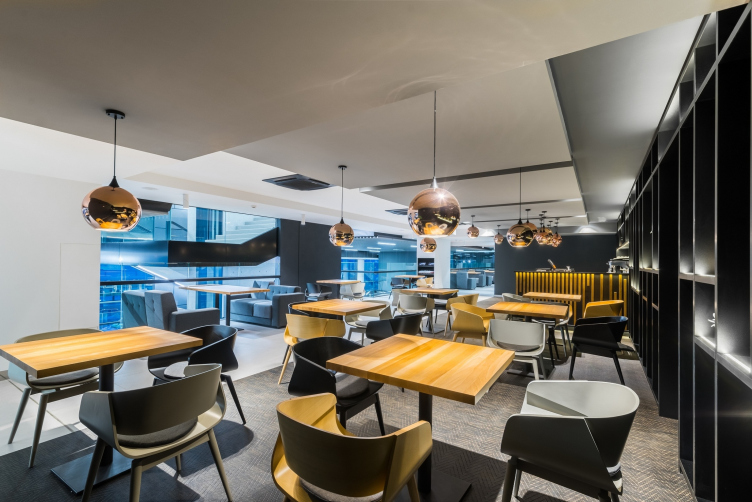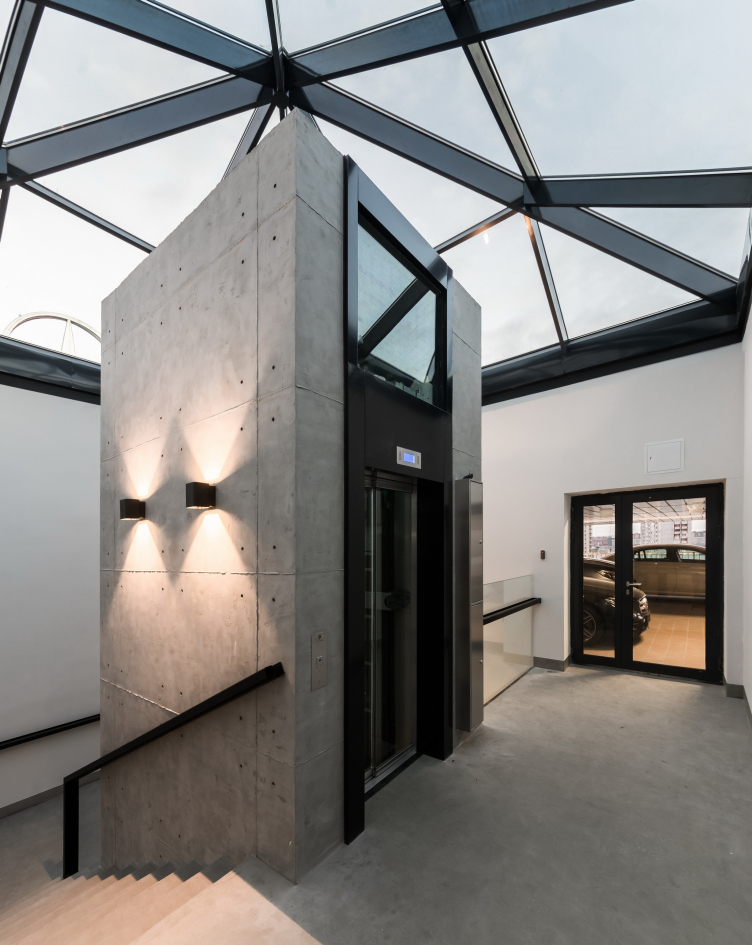Construction standards for car dealerships
The car dealership has long since become a typology in its own right, its basis consisting of rigorous brand book rules that cover the standards for designing, planning, and decorating car dealerships and repair shops, developed by every car manufacturer. The thick “bibles” provide for every minute detail, including the color and the type of decoration material that is allowed to be used in the interior design of this or that functional zone.
At the dawn of the rebirth of the capitalist economy in Russia, the requirements for observing the brand book rules were not particularly strict. The market was booming, and what mattered most was the flashiness of the architecture of the car dealership building. During that period, the Russian architecture got a fair number of curious buildings but, just like many other things, this approach became history, to be replaced by a more rational one: with simple orthogonal volumes, large stained glass façades, hi-tech or pseudo hi-tech structures, and the inevitable giant brand logo on top of the building. Seemingly, in such a situation car dealerships could hardly be interesting to architects as the testing ground for their creative search and professional discoveries. Nevertheless, even within the confines of this typology with its brand restrictions, the leading Russian architects keep on searching for and creating interesting and unusual projects that can claim a high-profile status.
The “A.Len” portfolio includes about forty projects of car dealerships in Saint Petersburg, two thirds of which have been implemented. One could say that this is one of the earliest and steadiest specialties of this architectural company – “A.Len” has worked with Infinity, Mercedes, Porsche, Lexus, Ford, and KIA Motors. The car repair and service complex “Avangard” on the Primorsky Avenue, designed and built by “A.Len” is the only large complex of this typology, built in Russia in 2017, and one of the largest in Europe. It offers not only the range of its anchor brand Mercedes but also its deluxe divisions of AMG and Maybach. In this project, the authors have demonstrated just how how much potential is hidden in this typology, seemingly limited by the confines of brand books standards.
"Avangard" car service center. Photograph © A.Gushchin
"Avangard" car service center. Photograph © A.Gushchin
***
Restrictions as a stimulus
Just like usual construction regulations, the requirements for organizing and equipping car dealerships can be subjectively perceived as an obstacle in the path of the architect’s creative self-expression but, if viewed in a positive light, they can become the catalyst of the creative process. For “A.Len”, such stimulus came in the form of the brand book of Mercedes and its AMG division when the company designed the new car dealership in Saint Petersburg.
The guidelines that must be observed in the course of the construction of car dealerships in any part of the world give detailed information on the measurements, configuration, and mutual arrangement of various functional zones, engineering solutions of the façades and their design, down to the use of columns of a certain geometry and color, and decoration materials of some certain types and manufacturers. Such standardization must seemingly limit the freedom of creative thought – but it turned out that in the case of “A.Len” it only sparks creativity. And the representatives of the brand in most cases support new unconventional ideas, especially if these help to raise the brand awareness and attract more customers.
"Avangard" car service center. Photograph © A.Gushchin
According to the leader of the company, Sergey Oreshkin, “it was an interesting exercise for the architect trying to come up with original and high-quality solutions staying at the same time within the rather rigid confines of the brand book which dictates the reserved portliness of the world-renowned brand. The building is expected to serve as the casing for the high-class deluxe product. This casing must be just as attractive as the showcased product – but not to the point of distracting the customer’s attention from the cars as such. It is like a box for a deluxe fragrance – the box must be perfect but still the real value is inside. This is why this “casing” must be different – one must see at once that this is the “wraparound” for the Mercedes cars. But, still, the real value, the product of this company, is inside”.
***
Simple form for valuable content
The architects proposed a laconic architectural form with a few volumetric elements serving to enhance its elegance. As their source of inspiration, the architects name the Richard Meier architecture with characteristic simplicity of volumes of perfect proportions.
The main volume of the car dealership building is essentially a six-story parallelepiped.
"Avangard" car service center © "A.Len"
From the south side, the volume is pierced by the cylindrical block of a ramp that leads to the usable roof where a 69-car parking lot is made. The main north side façade commanding one of the busiest thoroughfares of Saint Petersburg – the Primorsky Avenue – is fully glazed and performs the function of a huge showcase. Standing parallel to the glass façade, there are slender metallic columns known to everyone who follows the history of this brand. These columns are always there in the Mercedes dealerships. A few years ago, these columns were dark blue, as a rule. Still, the brand keeps abreast of the times, discovering new colors, at the same time staying the paragon of respectable chic.
"Avangard" car service center © "A.Len"
The requirement for setting the columns up against the façade gave the architects an opportunity to liven up its plastique. The tectonic logic prompted some crowning element, whose role is now played by the massive slab of the marquee overhanging above the whole façade and the terrace on the sixth floor where soon a restaurant will open for the guests of the dealership. What is interesting is the fact that the brand book allows for using a thin marquee but the architects proposed a more massive form tied in with the proportions and main sections of the building, and insisted on its implementation, thanks to which the façade got an imposing-looking complement.
"Avangard" car service center © "A.Len"
Yet another successful innovation proposed by the architects is an unusual system of demonstrating the cars. According to the authors’ concept, the three middle floors showcase all the current models of the brand along the length of the entire façade. To boost the effect, the designers recommended to place in only white cars exclusively this giant showcase. They are more noticeable in the daylight, while at night, thanks to a special backlighting system, they literally glow. This architectural solution proved to be successful from the marketing standpoint as well. The exposition of cars put on display behind the glass façade is plainly seen from the junction of the Western High-Speed Diameter, which runs but a few dozens of meters away from the façade. This way, the new Mercedes cars are guaranteed to be seen by tens of thousands drivers that daily pass through this junction.
***
Noblesse Oblige
Choosing the architectural and engineering solutions for the complex, the architects tried to highlight the features characteristic of the Mercedes brand: advanced technology level, perfection in form and function, dependability, and durability.
"Avangard" car service center. Photograph © A.Gushchin
The high quality standards, generally expected from the car dealerships of the famous German brand, were shown most vividly in the choice of the façade glazing system. Traditionally, when It comes to glazing a significant amount of square meters, Russia uses a rather cost-efficient combined subsystem, in which the steel elements (bearing the main load) are combined with extra aluminum ones, which are designed for installing the insulated glass units into them. The pileup of auxiliary structures is detrimental to the outward appearance of the building, and, besides, it levels out the glass wall effect, whose main value consists in its transparency. There are alternative systems on the market, in which all of the elements are made of steel, thanks to which one can cover really broad spans, the substructure looking slender and elegant – but such alternatives are oftentimes prohibitively expensive and are difficult to install. Hitherto, in Saint Petersburg, such steel façades have only been used in small-scale single-story buildings, the only exception being the Porsche dealership that pulled a stunt of installing a 10-meter-high system.
Realizing, just how high the bar was raised for them in terms of their design and engineering solutions standing up to the quality of the Mercedes cars, the A.Len architects convinced their client in the necessity of using the steel system for the main façade of the “Avangard” dealership. Ultimately, by using the Finnish-made steel profile, the architects were able to make a unique 20-meter high stained glass window consisting of glass sections 5 meters tall, which looks a worthy complement both to the exterior and the interior of the dealership building.
"Avangard" car service center © "A.Len"
The other façades of the complex are designed in a more pragmatic way, yet still in full accordance with metric and proportional guidelines developed for this building. The measurements and the pattern of glazing, as well as the choice of the type and the method of the façade coating are defined in accordance with the function of this or that zone inside of the building. The glass showcase used for demonstrating the luxury cars is followed by the standard bands of the single and double-story windows of the administrative part of the building, the size of the windows defined by the number of workplaces in the office.
"Avangard" car service center © "A.Len"
"Avangard" car service center © "A.Len"
With the transition to the service zone, the pattern of the apertures changes again. On the rear façade, the leitmotif is presented by vertical windows and the cylindrical volume of the ramp, pierced, like with a decorative stitch, with square technical windows. Initially, it was planned that the ramp would be unheated and covered with a high-tech grille, but later on down the line the architects refrained from this idea: they settled for a warm façade that protects the circular ramp from the precipitation and icing up.
***
The Inside World
As one can easily guess, working on the design and planning of the inside spaces was several times as difficult and required much more time than designing the outward appearance of the building. However, all the difficulties, including those that were connected with getting the approvals from the brand representatives about this or that design solution, were ultimately worth it, the authors of the project say. Sergey Oreshkin comments on the necessity of keeping the author control at every stage of the project: “In the recent years, we have been more and more frequently taking on the interior design parts of our projects as well because we were often faced with a situation when some side design company just would not perceive the interior design as an integral architectural solution of the entire building, which really had a negative impact on the end result”.
Interiors of the "Avangard" car service center. Photograph © A.Gushchin
Interiors of the "Avangard" car service center. Photograph © A.Gushchin
The “A.Len” architects defined the character of the “Avangard” inside spaces as “male”, combining the features of refined hi-tech style and the noble club-style reserve. The graphics character and the careful attention given to every detail is what sets this interior apart, making it the perfect backdrop for demonstrating the brands of Mercedes, AMG and Maybach.
Interiors of the "Avangard" car service center. Photograph © A.Gushchin
Interiors of the "Avangard" car service center. Photograph © A.Gushchin
As for the interior decoration materials used here, these are chiefly metal and glass. Only occasionally one will see an accent of wood or brutalist concrete. As their main colors, the architects chose white and black, logically complemented by a few shades of gray and the amber color of natural wood, which is to be seen in the decoration of the lounges designed for the customers’ longer stays, such as the waiting lounge and the cafés. The color set of the spaces clearly responds to their functions: the light presentation spaces are designed with white prevailing; the dark technical zones are dominated by black. In the transition zones, the two colors are combined and equally represented.
Interiors of the "Avangard" car service center. Photograph © A.Gushchin
In order to stress the graphic of the space, the architects are introducing an additional system of accepts – sources of light, different in shape and function, not only playing their direct part but also bringing in a twist of drive and helping to organize intuitive navigation. In addition, in the AMG zones, where the customized cars are showcased, light and audio effects create a special atmosphere that enhances the exclusiveness and high status of each car.
Interiors of the "Avangard" car service center. Photograph © A.Gushchin
Interiors of the "Avangard" car service center. Photograph © A.Gushchin
Some excessive refinement inherent to the interior design is explained by the firm attitude of the authors. “We always opt in favor of reserved interior design because we realize that later on life will inevitably come into it, bringing along chaos and spontaneous decor. In this specific instance it will be the sales equipment, cars, employees, and customers. The building will start living a life of its own. And we will never be able to control the end result. This is why it is ever so important to leave your interior design slightly “incomplete”, leaving room for future development” – Sergey Oreshkin explains his vision.
Interiors of the "Avangard" car service center. Photograph © A.Gushchin
***
New Standards for the Brand Book
The work that “A.Len” performed on developing the project of “Avangard” dealership made the most powerful impression on the German experts who were present at the inauguration of the new Mercedes center. Guided by the principles of the trademark brand book, the architects were able to find and prove their point during the consulting sessions, and, most importantly, implement in today’s Russian conditions, a lot of solutions that break away from the “letter” of the existing guidelines but clearly express their “spirit”. The creative treatment of the rules and regulations, and the unconventional approach lead to the creation of an effective, comfortable, and aesthetically appealing space for presenting the product of this legendary company, and were duly acclaimed. The German experts even offered to include some of the novelties into the trademark brand book, which can be considered as the token of unconditional recognition.

